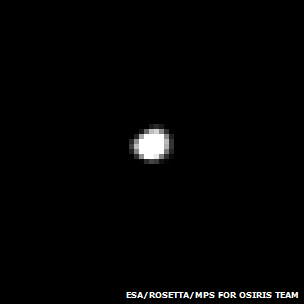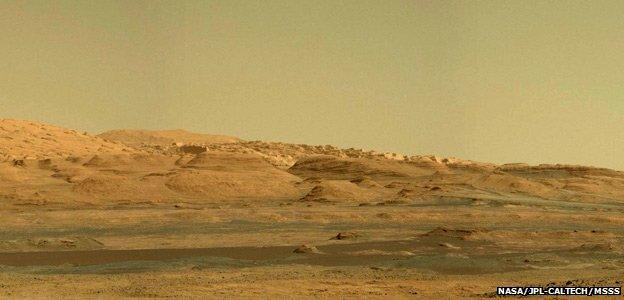Rosetta edges towards Comet 67P
- Published
- comments

Are we nearly there yet? Image taken from a distance of about 86,000km
Europe's Rosetta spacecraft is edging ever closer to its quarry - the 4km-wide Comet 67P/Churyumov-Gerasimenko.
Thursday's separation is just 43,000km, and the narrowing gap is evident in the probe's latest photo release.
The new image shows the great mountain of ice now taking up several pixels, and 67P will just get bigger and bigger over the coming weeks.
Controllers at the European Space Agency are aiming to get Rosetta, external into orbit around the comet on 6 August.
On Wednesday, they completed successfully the latest burn on the satellite's thrusters.
It was the fifth in a sequence of 10 that are needed to refine the final approach, bringing the probe to an eventual “miss distance” under 100km and a relative velocity that is pretty much walking pace.
The remaining burns will be done weekly, rather than fortnightly as has been the case so far.
In addition, Rosetta is now close enough that it can use its navigation cameras to plot the manoeuvres, instead of relying solely on its Osiris, external science camera system.
The navigation cameras will be particularly important once the probe arrives at the comet.
Rosetta will execute a pyramid-shaped orbit, external around the object, and it will employ the navcams to look for “landmarks” on the surface to understand where it is in space and how it is moving.
Already, the science is beginning to flow.
The probe’s Miro, external (Microwave Instrument for Rosetta Orbiter) spectrometer has reported the first detection of water vapour at 67P.
Miro got a view of the comet back in early June when the separation was much greater – some 360,000km. But it still managed to sense water vapour coming away from the object.
Miro detected on the order of 10 trillion, trillion molecules of water being lost every second – enough to fill a couple of those plastic cups at a water cooler.
The new image captured by Osiris covers about four pixels and was actually taken on 28 June from a distance of about 86,000 km.
I know it looks more like six or seven pixels, but that is really just the result of the physical effects of the way light is spread inside the imaging system. It is certainly not evidence of a coma. A gaseous shroud is sure to develop as the comet moves closer to the Sun and warms its ices - but it's not there yet.
Esa has also released a little “movie” of Osiris images, external showing 67P rotating with a period of 12.4 hours.
Ground telescopes had previously calculated a rotation of 12.7 hours. However, it would be premature to suggest something has changed, perhaps because of activity on the comet. The different numbers may simply be a product of the different imaging systems and vantage points.

Throughout July, we’ll now get a picture a week from Osiris.
You may wonder why we won’t get them more frequently. This is tricky one.
Clearly, there is a public imperative to see more. After all, it is European taxpayers who’ve funded Rosetta: “We own it”.
That said, the scientists at the Max-Planck-Institute for Solar System Research (MPS), external have invested a huge amount of time and effort in their camera system, and understandably claim intellectual primacy on its products.
If pictures were shoved out willy-nilly, so the argument goes, there’s a danger that independent researchers could spot something and publish discoveries “for free”. And this sort of thing does go on.
Within weeks of the first all-sky image from Esa’s Planck telescope being released, there were papers being published on what it purportedly contained by scientists outside the mission – and this was just with an image given to the media; its resolution and quality were far below what the Planck team had in-house.
Those papers are now long forgotten following the Planck team’s full and proper analysis, but they illustrate what can occur.
So, the limited Osiris release is the compromise that has been struck.
There is a counter-argument, of course, and you can see it every day by going to the raw image feed from the US space agency’s Curiosity rover, external.
Tens of pictures are downlinked every 24 hours from its cameras and put straight on the web.
You can – and I do – have a lot of fun putting these pictures into a panorama app on a smartphone to make big mosaics of Gale Crater.
This raw feed approach really started with the Spirit and Opportunity rovers, external a decade ago. Cassini at Saturn does something similar, external.
I remember in the days following Curiosity’s landing the project scientist John Grotzinger being asked if the dump of raw images risked his team being scooped on discoveries.
“So be it”, was his answer: this was how it was now done at Mars. And it is certainly true that an expectation has developed that there should be more frequent public access to space mission images.

You can have hours of fun making Mars panoramas on your smartphone